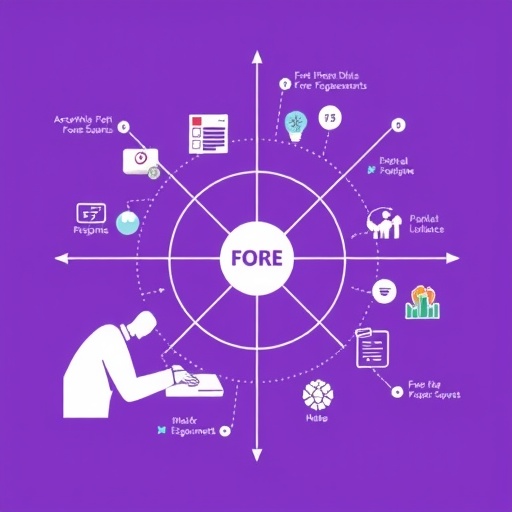In recent years, technology has dramatically transformed the landscape of education, creating both opportunities and challenges for educators and learners alike. A study conducted by Eitel, Krebs, and Schöne introduces a pivotal framework designed to address these complexities: the FoRe-Squares Model. This model, which stands for Focus, Support, and Reward, underscores essential components that can predict the effectiveness of technology-augmented instruction. The researchers aim to clarify the dynamics of how technology influences learning environments and the role that these three predictive factors play.
The FoRe-Squares Model is predicated on the idea that effective instruction in technology-rich classrooms hinges upon three critical elements. First and foremost is “Focus,” which pertains to the learner’s ability to maintain attention on educational tasks amidst distractions. In the digital age, where notifications and multitasking are the norms, maintaining focus is increasingly challenging for students. The researchers assert that cultivating an environment where students can concentrate effectively is crucial to their success in technology-augmented scenarios.
The second element, “Support,” refers to the various forms of assistance that educators can provide to learners. This support can manifest in many ways, from emotional encouragement to the provision of resources that facilitate learning. The study highlights that the right type of support not only encourages student engagement but also enhances motivation—an essential component of effective learning processes. The researchers elaborate on different forms of support, emphasizing the importance of tailored interventions that address individual learning needs.
Following Support is the element of “Reward.” In the context of the FoRe-Squares Model, rewards do not solely refer to traditional academic accolades but also encompass the intrinsic motivators that drive students to engage with technology and learn effectively. The research suggests that an understanding of how rewards can be effectively implemented in technology-enhanced learning environments can lead to significant improvements in student performance and engagement. This concept touches on a vital aspect: the psychological principles underlying motivation and how they can be leveraged within educational technology.
Through the application of the FoRe-Squares Model, educators can gain greater insights into crafting instructional strategies that are responsive to the dynamics of modern classrooms. This framework provides a holistic view that can guide teachers as they navigate the complexities of integrating technology into their instruction. It encourages them to think critically about how focus, support, and rewards operate in conjunction with one another to influence learning outcomes.
One of the striking implications of the FoRe-Squares Model is its adaptability. The researchers stress that this framework is not static but rather can be modified to fit varying educational contexts. Whether in a primary school setting or higher education, the principles encapsulated in the model can be employed to enhance instructional effectiveness regardless of the technological tools at the educator’s disposal. This adaptability offers immense potential for promoting educational equity, as it can be tailored to meet the diverse needs of learners from various backgrounds.
Moreover, the study’s findings underscore the significant gaps that often exist in teacher training programs concerning technology integration. Many educators enter the workforce without adequate preparation to utilize technology effectively in their teaching practices. By providing a clear and structured approach to technology-aided instruction, the FoRe-Squares Model could serve as a foundational tool in teacher education. In essence, empowering educators with this knowledge can help mitigate these gaps, fostering a generation of teachers who are competent and confident in utilizing technology within their classrooms.
The researchers also emphasize the importance of real-world testing and validation of the FoRe-Squares Model. Conducting empirical research to measure the model’s effectiveness in various educational settings will be crucial. Through longitudinal studies and diverse sampling, the researchers hope to gather data that will further corroborate the model’s utility and establish best practices for its implementation. This ongoing inquiry promises to contribute to the broader educational discourse surrounding technology usage.
As educational technology continues to evolve, the FoRe-Squares Model offers a timely contribution to the conversation about effective instructional methodologies. The need for evidence-based strategies is more critical than ever as students increasingly engage with digital tools. By focusing on the triad of focus, support, and reward, education can move towards more systematic and effective approaches to technology integration, ensuring that learning is both engaging and impactful.
The global implications of this research extend beyond the academic field into the realms of policy and practice. Educational institutions, policymakers, and stakeholders are urged to consider integrating the principles from the FoRe-Squares Model into broader educational frameworks. These considerations should inform decisions around budget allocations, technology procurement, and teacher training programs, ensuring that the educational infrastructure supports effective technology-enhanced learning.
In conclusion, the work of Eitel, Krebs, and Schöne highlights a crucial intersection of technology and pedagogy. By elucidating the roles of focus, support, and reward in educational contexts, the FoRe-Squares Model stands as a valuable framework for advancing technology-augmented instruction. As educators grapple with the challenges posed by digital learning environments, this model serves as a beacon for promoting effective teaching practices and enhancing student learning experiences in a technology-driven world.
The insights provided in this study may well serve as a catalyst for further exploration and innovation in how instructional methodologies can evolve alongside emerging technologies. Ultimately, fostering a well-rounded understanding of these dynamics will be key to preparing successful learners capable of thriving in the challenges of the 21st-century landscape.
Subject of Research: Technology-Augmented Instruction
Article Title: Introducing the FoRe-Squares Model: Focus Support and Reward as Key Predictors of Effective Technology-Augmented Instruction
Article References:
Eitel, A., Krebs, MC. & Schöne, C. Introducing the FoRe-Squares Model: Focus Support and Reward as Key Predictors of Effective Technology-Augmented Instruction.
Educ Psychol Rev 37, 67 (2025). https://doi.org/10.1007/s10648-025-10045-z
Image Credits: AI Generated
DOI: 10.1007/s10648-025-10045-z
Keywords: Technology, Education, Instructional Strategies, Pedagogy, Learning, FoRe-Squares Model, Teacher Training, Focus, Support, Reward.




